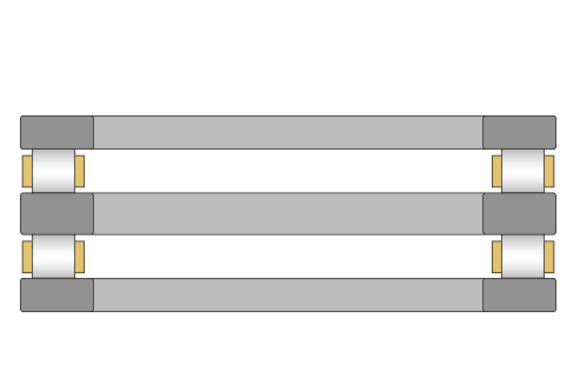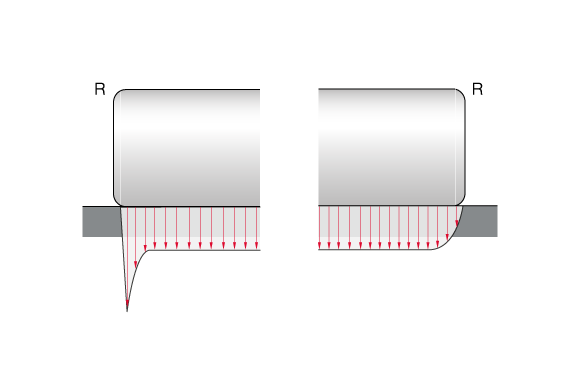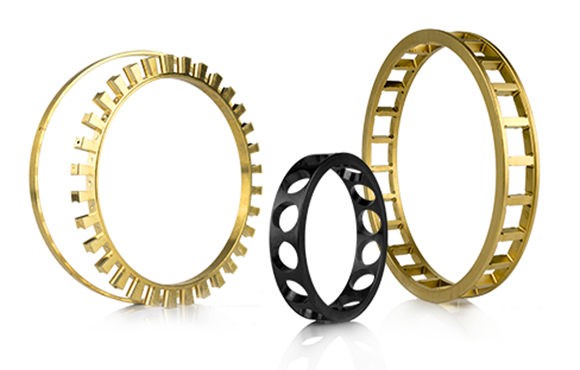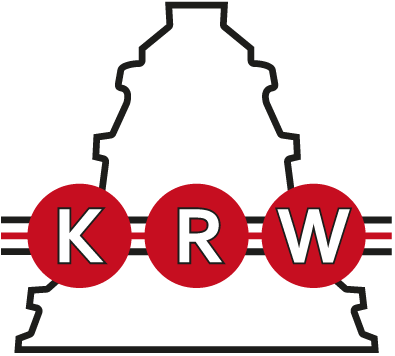
Cylindrical Roller Thrust Bearings
double direction
- Absorption of axial forces from both directions
- No absorption of radial forces
- Only suitable for up to medium speeds

Double direction cylindrical roller thrust bearings consist of one shaft washer, two housing washers and two axial roller cage assemblies. They can absorb high axial forces from both directions, but no radial forces. Double direction cylindrical roller thrust bearings are non-latching, so the roller cage assemblies and the bearing rings can be assembled separately.
Dimensions and Tolerances
KRW supplies double-sided cylindrical roller thrust bearings with normal tolerance (PN) in accordance to DIN 620-3 (Tolerances for roller bearings) and ISO 199 (Thrust bearings – Geometrical product specification (GPS) and tolerance values). All other deviating or special tolerances must be specified with the order.

Double-sided cylindrical roller thrust bearing
Bearing Design
Double direction cylindrical roller thrust bearings are dismountable and non-latching bearings. They can absorb high axial forces from a single direction, but no radial forces.
As an alternative for the externally centred housing washer or internally centred shaft washer, a race washer can be used when there is no need for an exact centring.

Roller profiling and tension distribution of cylindrical rollers in comparison. Left without profiling, right with profiling
Due to the logarithmic profiling of the cylindrical rollers, damaging edge tension and resulting premature failure are avoided.
Bearing Clearance
The bearing clearance for single direction cylindrical roller thrust bearings is adjusted only after installation according to operating conditions. The temperature-dependent length variation of the operating components must be considered.

Cage
By default, KRW cylindrical roller thrust bearings are equipped with a solid brass cage (suffix: M). Other cage designs are available on request or chosen for specific applications and labelled accordingly on the bearing.
Suffixes
Compensation of Angular Misalignments
Double direction cylindrical roller thrust bearings are not suitable for compensation of misalignments. Misalignments cause edge stresses between rolling elements and raceways and produce additional stresses in the bearing which reduce its operating life.
Speed
KRW distinguishes between kinematic limiting speed nG and thermal reference speed nth. The kinematic limiting speed is a practical mechanical limit value and is based on the mechanical fatigue strength of the rolling bearing as a function of its installation situation and lubrication. The limit speed must not be exceeded even under optimum operating conditions without prior consultation with KRW.
The DIN ISO 15312 (Rolling bearings - Thermal speed rating) does not specify a thermal speed rating nth for these bearings.
Admissible Operating Temperatures
The admissible operating temperature of a bearing is limited by cage material, dimensional stability of the bearing components (ball race and rolling elements), as well as lubrication. By default, KRW bearings are stabilised up to 200°C (S1). KRW provides roller bearings for higher operating temperatures on request.
Dimensioning
For dynamically loaded bearings
The service life formula according to ISO 281 L10 = (C/P)p for dynamically loaded bearings requires an equivalent load (P) from constant direction and size. To calculate P, calculation factors and the ratio of axial and radial load are required.
Equivalent Dynamic Bearing Load Pa
The equivalent dynamic bearing load can be determined using the following formula:

| Pa | equivalent dynamic load | [kN] |
| Fa | dynamic axial force | [kN] |
For statically loaded bearings
Dynamic dimensioning loses its validity for bearings rotating at very low speeds (n x dm ≤ 4000 mm/min). The static load safety factor S0 is calculated as follows:

| S0 | static load safety factor | [-] |
| C0a | static load rating (from bearing chart) | [kN] |
| P0 | equivalent static bearing load | [kN] |
| n | speed | [min-1] |
| dm | mean bearing diameter [dm = (D+d)/2] | [mm] |
Static load capacity

Minimum Axial Load
A minimum load is required for the reliable operation of a rolling bearing. If the minimum load is not reached, slippage may occur. This produces surface damage which leads to premature bearing failure. Cylindrical roller thrust bearings are protected against slippage exclusively through a minimum axial load. The calculation for the minimum axial load for cylindrical roller thrust bearings is shown in the following formula:




